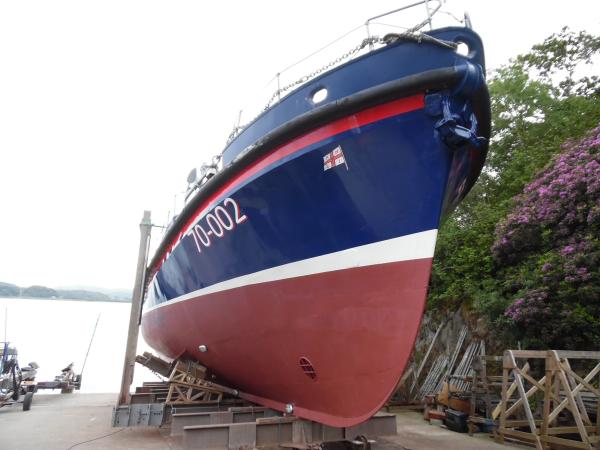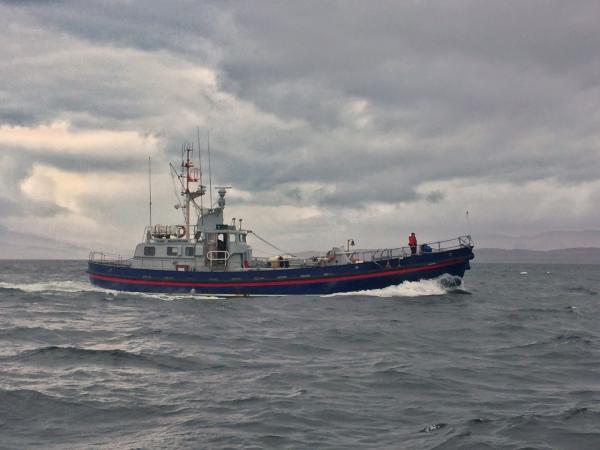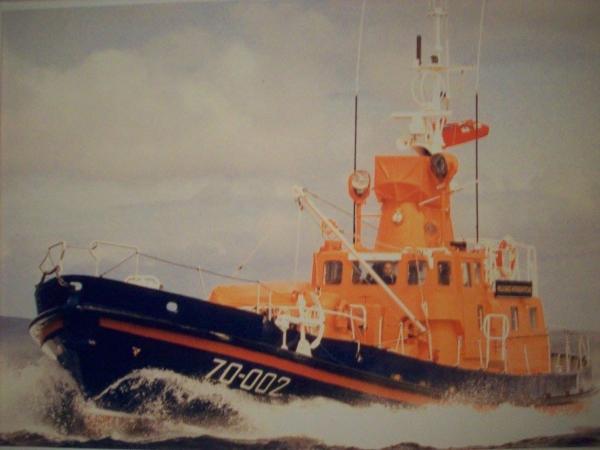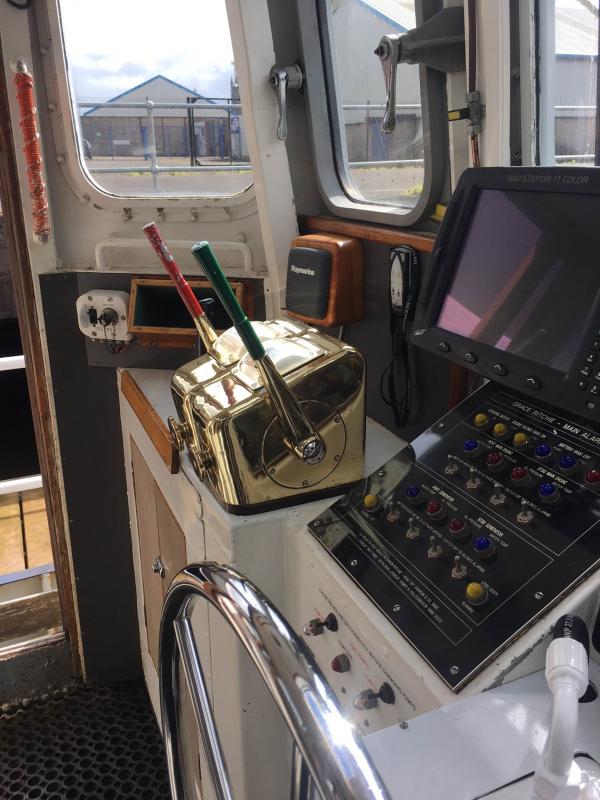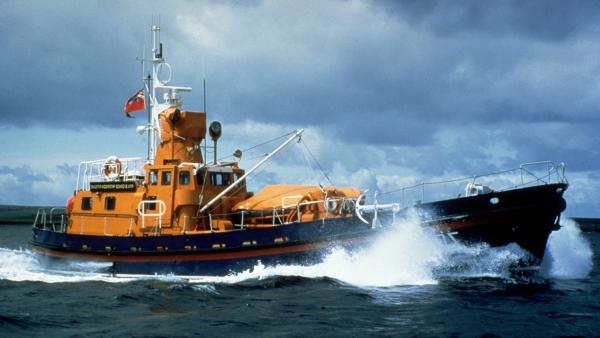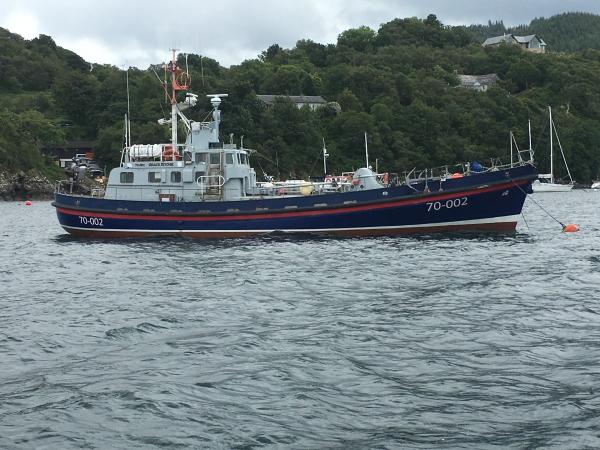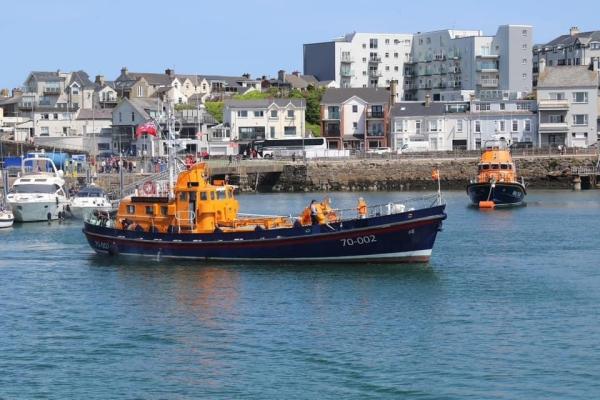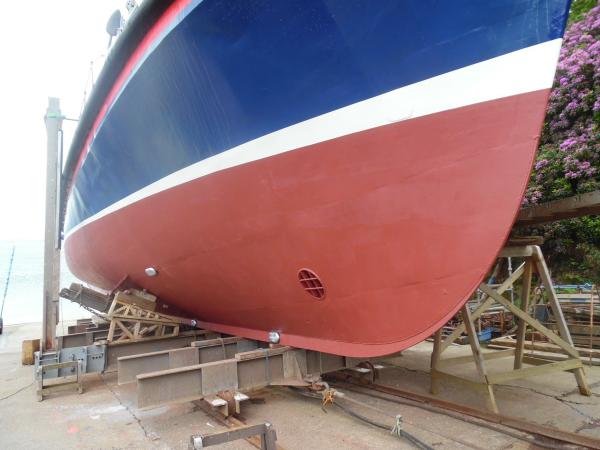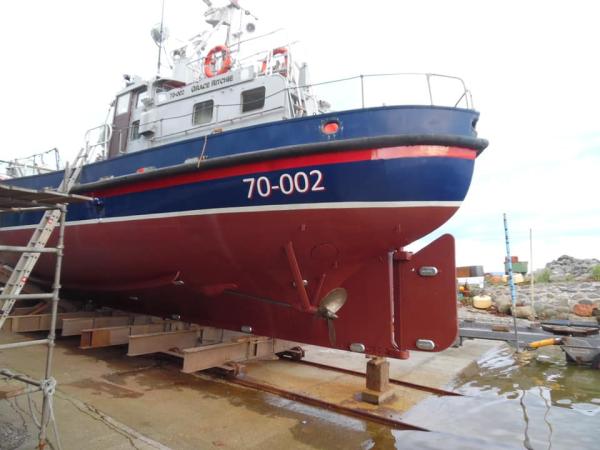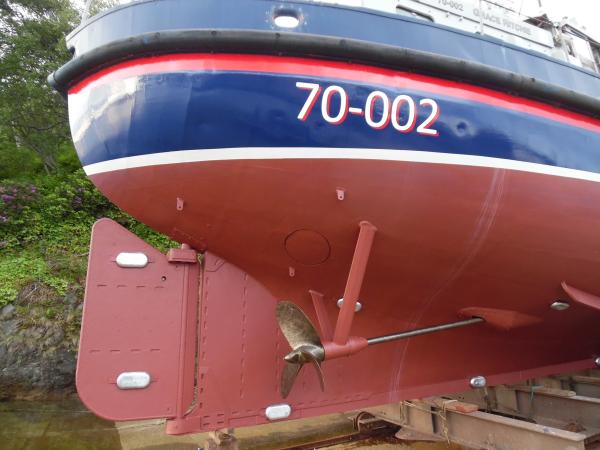

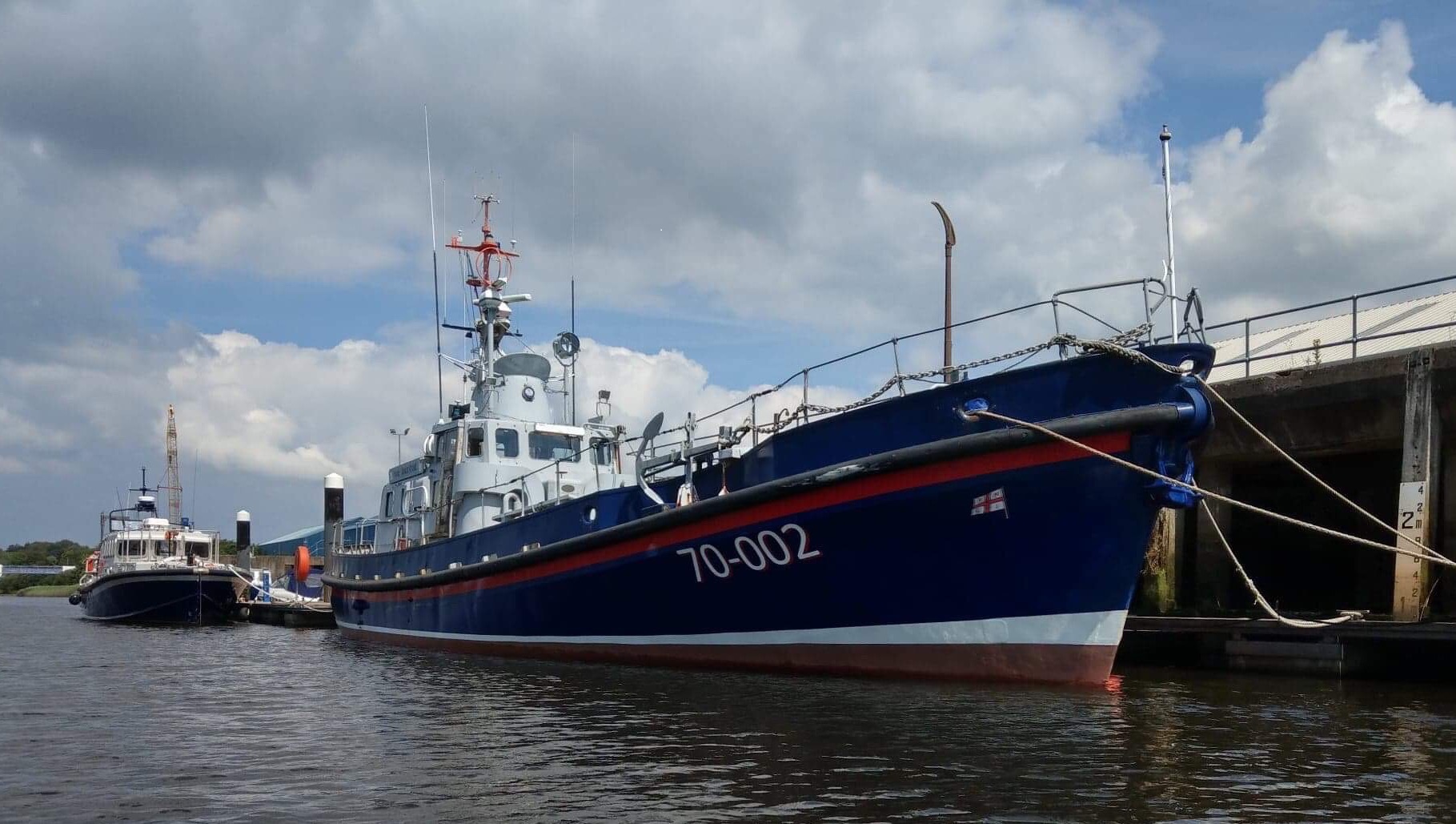
Previous names
- 1965 Grace Paterson Ritchie
Details
Construction
Dimensions
History
RNLB GRACE PATERSON RITCHIE, 70-002 ON988, is an RNLI ‘Clyde Class’ Lifeboat. She was designed by John Tyrrell of Arklow, for the RNLI and built by Yarrow’s of Scotstoun, on the Clyde in 1965. She was named, GRACE PATERSON RITCHIE after the lady from Skelmorlie, who bequeathed the £65,000 required for its construction. She was launched in 1966 and named at Wemyss Bay Pier, on the 6th of September 1967.
The Clyde-Class Lifeboat was operated by the Royal National Lifeboat Institution (RNLI) from two of its stations in the United Kingdom, Kirkwall and Clovelly. Only three vessels were built for the RNLI and GRACE PATERSON RITCHIE is the last remaining example in original Service Condition.
Following a visit in the early sixties to lifeboat societies in the Netherlands and West Germany, which successfully employed cruising lifeboats, the RNLI's Management Committee decided to sanction the construction of two such boats for RNLI service. The first two boats went on trials in 1966 and in 1968 went on station at Clovelly and Kirkwall. The third boat was built as a relief but took over as station boat at Clovelly, with the first boat becoming the relief. It eventually became apparent that cruising type boats were not really suited to the RNLI's operations and the boats were used at their respective bases as normal lifeboats until withdrawal in 1988.
This Class of Lifeboat was the largest ever built for the RNLI and the only Class ever designed to be permanently manned. It has accommodation for her Crew; Cabins, Berths, Showers, Heads and Galley. She has a double hull construction, the space between the inner and outer hulls, filled with foam buoyancy. In addition, there are double bottom tanks, for fuel, water and ballast. The hull is divided athwartships by seven, watertight bulkheads. There are two Engine Rooms, separated by a longitudinal, watertight, bulkhead. Each Engine Room houses a Gardner 8L3B, diesel engine of 230 hp, together with a 30kva 230v generator in each Engine Room.
Following extensive Trials and Demonstrations around the British Isles and Scandinavia, GRACE PATERSON RITCHIE was stationed temporarily at Kirkwall. In 1969, both her and the Longhope Lifeboat, “TGB”, were launched to aid the Merchant Ship “Irene”, which was in peril, in hurricane conditions, in the notorious Pentland Firth, off the Orkney Islands. In one of the greatest tragedies in the history of the RNLI, the Longhope Lifeboat was lost on Service, in the maelstrom, with all of her gallant and brave Crew. “Grace Paterson Ritchie” fell off a 60ft wave that night, but survived. At this time in RNLI history, Lifeboats, including “Grace Paterson Ritchie”, were not self-righting. The loss of the Longhope Lifeboat, “TGB”, led to the permanent establishment of GRACE PATERSON RITCHIE in Orkney.
She and her crews served with great distinction, receiving many Awards, Medals and Commendations, both at Kirkwall, where she launched on 82 occasions and saved 46 lives and later, in 1974, at Clovelly in Devon. In total service she was 197 launches and 86 lives saved and received two bronze medals
When the Clyde Class Lifeboats were withdrawn from Service by the RNLI in 1988, GRACE PATERSON RITCHIE was sold to the Icelandic Lifesaving Association. She left Kirkwall for Iceland, on the 22nd March 1989, to become the REYKJAVIK Lifeboat. She served there with further and great distinction and remained in faithful Service until 2002.
GRACE PATERSON RITCHIE was then saved from an uncertain future, by, Mr. Iain Crosbie and his late father. He purchased her, returned her to the Clyde for refit and subsequently maintained her, in her original Service design, to the highest standards. Subsequently sold to Mr. John Clarke, who, in maintaining continuity of RNLI Heritage, sold her to her current owner.
Since March 2019, she has been in the process of full, comprehensive restoration to her original RNLI build design. This extensive restoration has been undertaken in four Phases and totals in excess of 26,000 work hours.
“Gracie’s” Restoration Project Plan was logistically difficult. Her new home Port of Coleraine’s lift capacity, ordinarily excellent at 50 tons, was not sufficient for “Gracie’s” 78 tons. Costings for hired in cranes were prohibitively expensive, thus her restoration required careful consideration, planning and design.
Phase 1, over 5 weeks involved making her safe and ready for sea. Her machinery required considerable attention, principally servicing both her main engines, gearboxes, reduction boxes, both generators, together with her steering and hydraulic systems.
Phase 2, comprised of her lift-out in Scotland, for investigation and comprehensive hull restoration. Her hull was grit blasted to facilitate a full ultrasonic survey. Results were a great relief in confirming that her Corten steel hull was practically as her build specification. Her shafts were drawn, rudder removed, together with propellers, seacocks and underwater components. All were replaced and rebuilt with new bearings, seals and anodes. Her hull was repainted and from keel to gunwales and relaunched for passage to the Port of Coleraine.
Phase 3, restoration of her decks, deck machinery, superstructure, mast and crane, together with sympathetic installation of modern safety and navigation equipment, whilst refurbishing her original systems. Preliminary works for Phase 3 required the design and fabrication of a temporary cover, to enable the works to proceed. Her guard rail stanchions were removed and 26 steel trusses were designed and fitted, utilizing the stanchion fixing holes on the steel gunwales. Wind and snow loadings proved problematic, but were overcome and a bespoke cover was manufactured locally in three interconnecting sections and successfully fitted. As “Gracie’s” RNLI designation was ’70-002’, this reusable, tempory structure is affectionately known at the ’002 Arena’.
All removable fittings were lifted off and disassembled, including her mast. Component parts were transferred to Maine Surface Finishing Group for grit blasting and coating with ‘Baril’ marine paint system, a system widely used on offshore marine installations.
Her superstructure and decks were similarly prepared, repaired and finished with the ‘Baril’ paint system by spray application. Logistically this was also difficult, given her pontoon berth position, relevant to the nearest hard standing 50 metres distant. This necessitated the design of a substantial and mobile paint delivery system. Two industrial compressors, together with two industrial air filter units, powered by a three phase generator were assembled on a covered trailer and towed into position. A large bore air, supply line was then laid to a further filter regulator unit on the vessel. Specified paint application temperatures, humidity and environmental factors were controlled onboard the vessel, by filtered supply and extract fans. Although only three colours were used, Orange, White and Grey, hundreds of hours were expended in masking of individual sections, prior to the next colour application, the largest masking her entire Orange superstructure. On completion, the paint application was allowed to cure for 14 days, following which the 22 metre cover was removed. She then moved to the quayside, where the temporary steel truss frame was lifted off by crane. All previously removed fittings and components were lifted back onboard by crane and reassembled. Her upper mast section now incorporating a concealed hinge design, allowing it to lower aft, with view to shed access for future maintenance.
Phase 4, Following return to her pontoon berth, she undertook extensive rewiring and ancillary works, together with installation of new navigation and communication equipment, compliant with MCA Area Category 0 Coding, for Unlimited Service. She maintains her build range of 1,700 nautical miles at 11.5 knots.
Grace Paterson Ritchie is an important vessel, not only in respect of her RNLI Service and heritage, but also her great significance to Irish and Scottish maritime heritage, having been designed by Irish Naval Architect, John Tyrrell of Arklow and build by Yarrows on the Clyde. Her restoration is in tribute to these remarkable institutions and to preserve their magnificent history.
Her mission now is to preserve RNLI heritage and contribute to its future. Although privately owned and funded, she is maintained in ‘Service Condition’ and used exclusively in promotion and fundraising for present and future RNLI generations, together with informing and educating on the history of the Institution, gallantry and narrative of crews past.
She regularly visits many RNLI Stations, throughout Great Britain & Ireland each year and welcomes visitors aboard at every opportunity.
Her restoration as of January 2024 is complete
Significance
- What is the vessel’s ability to demonstrate history in her physical fabric?
Evidence for designs, functions, techniques, processes, styles, customs and habits or uses and associations in relation to events and people. How early, intact or rare these features are may impact on significance.
GRACE PATERSON RITCHIE is a Clyde class lifeboat, designed by John Tyrrell of Arklow and based on a combination of fishing and pilot boat lines. The class was the largest to be built by the RNLI, the first with a steel hull and the only one designed to be permanently manned. GRACE PATERSON RITCHIE had slightly different dimensions to the first of the class, being slightly smaller at 70 feet long with a beam of 17 feet. She has a double hull construction and the space between the inner and outer hulls is filled with foam buoyancy. In addition, there are double bottom tanks, for fuel, water and ballast. The hull is divided athwartships by seven, watertight bulkheads. There are two engine rooms, each housing the original Gardner 8L3B diesel engine of 230 hp, together with a 30kva 230v generator. She has an aluminium alloy superstructure and a flying bridge. An inflatable inshore boat was carried forward of the wheelhouse. GRACE PATERSON RITCHIE has now been conserved back to her original RNLI design and configuration. Her hull remains in original condition, her decks, deck machinery, superstructure, mast and crane have been restored and modern navigation aids have been installed sympathetically. She maintains her build range of 1,700 nautical miles at 11.5 knots.
- What are the vessel’s associational links for which there is no physical evidence?
Associations with people or places. Off-ship research.
GRACE PATERSON RITCHIE was built by Yarrow Shipbuilders of Scotstoun on the Clyde to a design based on Netherlands and West Germany cruising lifeboats. She was named after a lady from Skelmorlie who bequeathed the cost of her construction to the RNLI and a vote of thanks was proposed by the Duke of Atholl at a naming ceremony which took place at Wemyss Bay Pier in September 1967. She initially took part in extensive trials and demonstrations around the British Isles and Scandinavia before being stationed at Kirkwell, giving her national associations, as well as a strong connection to Scotland. She moved to Orkney following the tragic loss of the Longhope lifeboat in 1969 and also acted as relief boat for Clovelly. GRACE PATERSON RITCHIE was taken to the Faroe Islands in 1975 to give a practical demonstration of her use, which brought the lifeboat to the attention of the Faroes Government and the public at large, gaining support for the establishment of their own lifeboat service. After being withdrawn from service, GRACE PATERSON RITCHIE was sold to the Icelandic Lifesaving Association and stationed in Reykjavik until 2002, giving her links with Iceland in the latter part of her working life. Only three vessels of this type were built for the RNLI. GRACE PATERSON RITCHIE was the second vessel built and is now the last remaining example in original service condition. She was launched 197 times during her career, with 86 lives saved and two RNLI bronze medals were awarded. She was recorded on the National Register of Historic Vessels in 2021.
- How does the vessel’s shape or form combine and contribute to her function?
Overall aesthetic impact of the vessel, her lines, material she was built from and her setting. Does she remain in her working environment?
GRACE PATERSON RITCHIE was designed as a cruising lifeboat in the style of a trawler, intended to travel long distances at speed and lie offshore in exposed waters, with a bigger radius of action than previous lifesaving craft. She had open deck space so she could operate with helicopters, twin diesel engines and a subdivided hull. As a permanently manned craft, GRACE PATERSON RITCHIE was fitted with accommodation for the crew in the form of cabins, berth, showers, heads and galley, although conditions on board were considered relatively spartan. With her RNLI livery, she is a distinctive, as well as a substantial craft and retains her original form. GRACE PATERSON RITCHIE remains in operational use under private ownership and regularly visits RNLI stations around the British Isles, welcoming the public onboard.
Source: NHS-UK team, March 2024
Key dates
-
1965
Built in 1965, and launch in 1966
-
1969
Stationed temporarily at Kirkwall
-
1969
In 1969, both her and the Longhope Lifeboat, “TGB”, were launched to aid the Merchant Ship “Irene”, which was in peril, in hurricane conditions, in the notorious Pentland Firth, off the Orkney Islands
-
1969
The loss of the Longhope Lifeboat, “TGB”, led to the permanent establishment of GRACE PATERSON RITCHIE in Orkney.
-
1988
She was sold to the Icelandic Lifesaving Association and served there until 2002
-
2003
Mr. Iain Crosbie and his late father. Returned to the Clyde
Own this vessel?
If you are the owner of this vessel and would like to provide more details or updated information, please contact info@nationalhistoricships.org.uk

